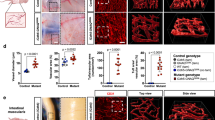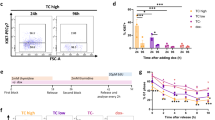Abstract
Down’s syndrome (DS) is a genetic disorder caused by full or partial trisomy of human chromosome 21 and presents with many clinical phenotypes including a reduced incidence of solid tumours1,2. Recent work with the Ts65Dn model of DS, which has orthologues of about 50% of the genes on chromosome 21 (Hsa21), has indicated that three copies of the ETS2 (ref. 3) or DS candidate region 1 (DSCR1) genes4 (a previously known suppressor of angiogenesis5,6) is sufficient to inhibit tumour growth. Here we use the Tc1 transchromosomic mouse model of DS7 to dissect the contribution of extra copies of genes on Hsa21 to tumour angiogenesis. This mouse expresses roughly 81% of Hsa21 genes but not the human DSCR1 region. We transplanted B16F0 and Lewis lung carcinoma tumour cells into Tc1 mice and showed that growth of these tumours was substantially reduced compared with wild-type littermate controls. Furthermore, tumour angiogenesis was significantly repressed in Tc1 mice. In particular, in vitro and in vivo angiogenic responses to vascular endothelial growth factor (VEGF) were inhibited. Examination of the genes on the segment of Hsa21 in Tc1 mice identified putative anti-angiogenic genes (ADAMTS18,9and ERG10) and novel endothelial cell-specific genes11, never previously shown to be involved in angiogenesis (JAM-B12 and PTTG1IP), that, when overexpressed, are responsible for inhibiting angiogenic responses to VEGF. Three copies of these genes within the stromal compartment reduced tumour angiogenesis, explaining the reduced tumour growth in DS. Furthermore, we expect that, in addition to the candidate genes that we show to be involved in the repression of angiogenesis, the Tc1 mouse model of DS will permit the identification of other endothelium-specific anti-angiogenic targets relevant to a broad spectrum of cancer patients.
This is a preview of subscription content, access via your institution
Access options
Subscribe to this journal
Receive 51 print issues and online access
$199.00 per year
only $3.90 per issue
Buy this article
- Purchase on Springer Link
- Instant access to full article PDF
Prices may be subject to local taxes which are calculated during checkout




Similar content being viewed by others

References
Yang, Q., Rasmussen, S. A. & Friedman, J. M. Mortality associated with Down’s syndrome in the USA from 1983 to 1997: a population-based study. Lancet 359, 1019–1025 (2002)
Hasle, H. Pattern of malignant disorders in individuals with Down’s syndrome. Lancet Oncol. 2, 429–436 (2001)
Sussan, T. E., Yang, A., Li, F., Ostrowski, M. C. & Reeves, R. H. Trisomy represses ApcMin -mediated tumours in mouse models of Down’s syndrome. Nature 451, 73–75 (2008)
Baek, K. H. et al. Down’s syndrome suppression of tumour growth and the role of the calcineurin inhibitor DSCR1. Nature 459, 1126–1130 (2009)
Iizuka, M., Abe, M., Shiiba, K., Sasaki, I. & Sato, Y. Down syndrome candidate region 1, a downstream target of VEGF, participates in endothelial cell migration and angiogenesis. J. Vasc. Res. 41, 334–344 (2004)
Minami, T. et al. Vascular endothelial growth factor- and thrombin-induced termination factor, Down syndrome critical region-1, attenuates endothelial cell proliferation and angiogenesis. J. Biol. Chem. 279, 50537–50554 (2004)
O’Doherty, A. et al. An aneuploid mouse strain carrying human chromosome 21 with Down syndrome phenotypes. Science 309, 2033–2037 (2005)
Luque, A., Carpizo, D. R. & Iruela-Arispe, M. L. ADAMTS1/METH1 inhibits endothelial cell proliferation by direct binding and sequestration of VEGF165. J. Biol. Chem. 278, 23656–23665 (2003)
Lee, N. V. et al. ADAMTS1 mediates the release of antiangiogenic polypeptides from TSP1 and 2. EMBO J. 25, 5270–5283 (2006)
Birdsey, G. M. et al. Transcription factor Erg regulates angiogenesis and endothelial apoptosis through VE-cadherin. Blood 111, 3498–3506 (2008)
Herbert, J. M., Stekel, D., Sanderson, S., Heath, V. L. & Bicknell, R. A novel method of differential gene expression analysis using multiple cDNA libraries applied to the identification of tumour endothelial genes. BMC Genomics 9, 153 (2008)
Aurrand-Lions, M., Duncan, L., Ballestrem, C. & Imhof, B. A. JAM-2, a novel immunoglobulin superfamily molecule, expressed by endothelial and lymphatic cells. J. Biol. Chem. 276, 2733–2741 (2001)
Holash, J. et al. Vessel cooption, regression, and growth in tumors mediated by angiopoietins and VEGF. Science 284, 1994–1998 (1999)
Williams, B. R. et al. Aneuploidy affects proliferation and spontaneous immortalization in mammalian cells. Science 322, 703–709 (2008)
Shalaby, F. et al. Failure of blood-island formation and vasculogenesis in Flk-1-deficient mice. Nature 376, 62–66 (1995)
Reynolds, A. R. et al. Elevated Flk1 (vascular endothelial growth factor receptor 2) signaling mediates enhanced angiogenesis in β3-integrin-deficient mice. Cancer Res. 64, 8643–8650 (2004)
Kelly, P. A. & Rahmani, Z. DYRK1A enhances the mitogen-activated protein kinase cascade in PC12 cells by forming a complex with Ras, B-Raf, and MEK1. Mol. Biol. Cell 16, 3562–3573 (2005)
Gampel, A. et al. VEGF regulates the mobilization of VEGFR2/KDR from an intracellular endothelial storage compartment. Blood 108, 2624–2631 (2006)
Lampugnani, M. G., Orsenigo, F., Gagliani, M. C., Tacchetti, C. & Dejana, E. Vascular endothelial cadherin controls VEGFR-2 internalization and signaling from intracellular compartments. J. Cell Biol. 174, 593–604 (2006)
Wolvetang, E. J. et al. ETS2 overexpression in transgenic models and in Down syndrome predisposes to apoptosis via the p53 pathway. Hum. Mol. Genet. 12, 247–255 (2003)
Liu, Y. J., Xu, Y. & Yu, Q. Full-length ADAMTS-1 and the ADAMTS-1 fragments display pro- and antimetastatic activity, respectively. Oncogene 25, 2452–2467 (2006)
Carbone, G. M. et al. Triplex DNA-mediated downregulation of Ets2 expression results in growth inhibition and apoptosis in human prostate cancer cells. Nucleic Acids Res. 32, 4358–4367 (2004)
Yamamoto, H. et al. Defective trophoblast function in mice with a targeted mutation of Ets2. Genes Dev. 12, 1315–1326 (1998)
Park, J. S. et al. A role for both Ets and C/EBP transcription factors and mRNA stabilization in the MAPK-dependent increase in p21Cip-1/WAF1/mda6 protein levels in primary hepatocytes. Mol. Biol. Cell 11, 2915–2932 (2000)
Shozu, M. et al. ADAMTS-1 is involved in normal follicular development, ovulatory process and organization of the medullary vascular network in the ovary. J. Mol. Endocrinol. 35, 343–355 (2005)
Harris, C. D., Ermak, G. & Davies, K. J. Multiple roles of the DSCR1 (Adapt78 or RCAN1) gene and its protein product calcipressin 1 (or RCAN1) in disease. Cell. Mol. Life Sci. 62, 2477–2486 (2005)
Reynolds, A. R. et al. Stimulation of tumor growth and angiogenesis by low concentrations of RGD-mimetic integrin inhibitors. Nature Med. 15, 392–400 (2009)
Reynolds, L. E. et al. Enhanced pathological angiogenesis in mice lacking β3 integrin or β3 and β5 integrins. Nature Med. 8, 27–34 (2002)
Mahadevan, V., Hart, I. R. & Lewis, G. P. Factors influencing blood supply in wound granuloma quantitated by a new in vivo technique. Cancer Res. 49, 415–419 (1989)
Acknowledgements
We thank G. Saunders, C. Wren, C. Pegrum and A. Slender for their help with animal husbandry; F. Wiseman and T. Broughton for information on gene deletions in the Tc1 mice; and L. Iruela-Arispe for advice on ADAMTS1 mice and antibody gift.
Author information
Authors and Affiliations
Contributions
L.E.R. and K.M.H-D. designed the experiments. L.E.R. performed the experiments. A.R.W. performed the bone marrow transplant experiments and stained for Y chromosome and conducted RT–PCR. G.D’A. performed the aortic ring assay. S.D.R. performed the phospho-VEGFR2 western blot analysis. T.A.J. and D.S. performed the tumour cell karyotyping. M.B. assisted with the immunostaining, tumour and sponge harvesting and flow cytometric analysis. C.J. and S.K. conducted flow cytometry and immunofluorescence of cells. B.A.I., R.A. and S.G.-U. supplied the JAM-B antibodies for western blot analysis and JAM-B wild-type and heterozygous mice for in vivo and ex vivo studies and JAM-B biochemistry in JAM-B heterozygotes. J.C.R.-M. and E.M.-E. provided the ADAMTS1 heterozygous aortae and ADAMTS1 PCR analysis. C.J.M. and A.T. provided the PTTG1IP antibody for western blot analysis. F.D.-B. and D.N. provided the human DS and normal control cells. V.J.T. and E.M.C.F. designed , developed and provided the Tc1 mice. L.E.R., K.M.H-D. and I.R.H. wrote the paper with substantial input from the other authors.
Corresponding author
Ethics declarations
Competing interests
The authors declare no competing financial interests.
Supplementary information
Supplementary Information
This file contains Supplementary Methods and Supplementary Figures 1-13 with legends. (PDF 2388 kb)
Rights and permissions
About this article
Cite this article
Reynolds, L., Watson, A., Baker, M. et al. Tumour angiogenesis is reduced in the Tc1 mouse model of Down’s syndrome. Nature 465, 813–817 (2010). https://doi.org/10.1038/nature09106
Received:
Accepted:
Issue Date:
DOI: https://doi.org/10.1038/nature09106
This article is cited by
-
Mouse models of aneuploidy to understand chromosome disorders
Mammalian Genome (2022)
-
Aneuploidy as a promoter and suppressor of malignant growth
Nature Reviews Cancer (2021)
-
iPSC-derived progenitor stromal cells provide new insights into aberrant musculoskeletal development and resistance to cancer in down syndrome
Scientific Reports (2020)
-
Pulmonary hemosiderosis in children with Down syndrome: a national experience
Orphanet Journal of Rare Diseases (2018)
-
Down syndrome: from the age of characterization to the era of curative approach
The Nucleus (2017)
Comments
By submitting a comment you agree to abide by our Terms and Community Guidelines. If you find something abusive or that does not comply with our terms or guidelines please flag it as inappropriate.


